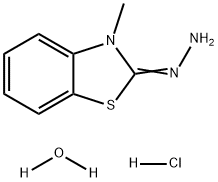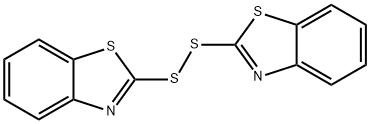MBTH indicator , 0.05%(w/v)inwater , 38894-11-0
Synonym(s):
2-Hydrazono-3-methylbenzothiazoline hydrochloride;MBTH hydrochloride hydrate
CAS NO.:38894-11-0
Empirical Formula: C8H12ClN3OS
Molecular Weight: 233.72
MDL number: MFCD00149370
EINECS: 684-573-8
| Pack Size | Price | Stock | Quantity |
| 100ML | RMB49.60 | In Stock |
|
| 500ml | RMB150.40 | In Stock |
|
| others | Enquire |
PRODUCT Properties
| Melting point: | 276-278 °C (dec.)(lit.) |
| storage temp. | 2-8°C |
| solubility | DMSO (Slightly), Methanol (Slightly) |
| form | Crystalline Powder and/or Chunks |
| color | White |
| Water Solubility | Soluble in water. |
| BRN | 4722243 |
| Stability: | Hygroscopic |
| InChI | InChI=1S/C8H9N3S.ClH.H2O/c1-11-6-4-2-3-5-7(6)12-8(11)10-9;;/h2-5H,9H2,1H3;1H;1H2/b10-8+;; |
| InChIKey | IYXXQOGEFHAQGU-PIHABLKOSA-N |
| SMILES | CN1/C(/SC2C=CC=CC1=2)=N\N.Cl.O |
| CAS DataBase Reference | 38894-11-0(CAS DataBase Reference) |
Description and Uses
3-Methyl-2-benzothiazolinone hydrazone hydrochloride monohydrate may contain free HCl. It is a reagent for the spectrophotometric determination of aliphatic aldehydes and traces of selenium (IV) in environmental samples. It can also be used to determine hexosamines in glycosaminoglycans. Additionally, it is helpful to study the effects of various hormones and neurotransmitters. Furthermore, this compound has been found to have a variety of effects on the cardiovascular system, the nervous system, and the immune system.
3-Methyl-2-benzothiazolinone hydrazine (MBTH) can be used as a reagent for the spectrophotometric determination of traces of selenium, tellurium, and cyanide in environmental samples.




